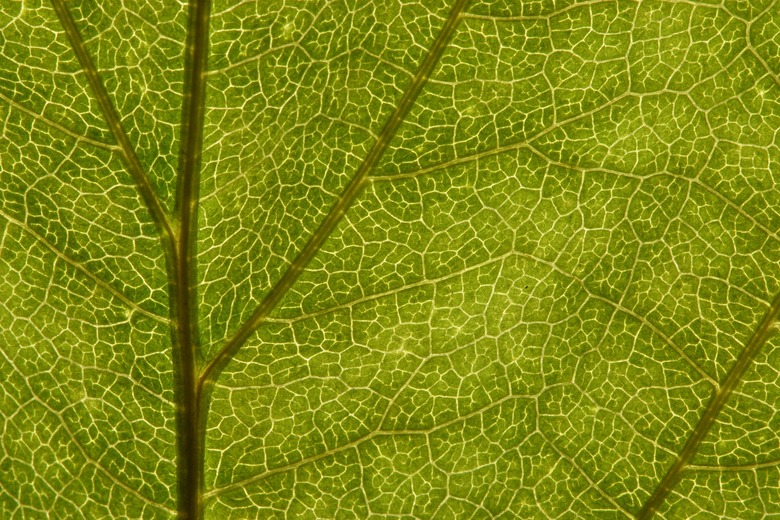Comparison Of Plant Cells & Human Cells
Plants and humans are both living organisms that rely on environmental factors to survive. While both eat, drink and breathe, the methods by which they do so greatly differ. This is due to basic differences in their cells. While the cells that make up each organism have some things in common, plant cells and human cells have distinct characteristics that make them instantly identifiable.
Read more about the similarities and differences between plant and animal cells (with chart).
Difference Between Plants and Animals
Difference Between Plants and
Animals
The structure of the cell can help you determine whether you are looking at a plant or animal cell. Animal cells are smaller and have a flexible outer membrane that allows gases, molecules and nutrients to pass into the cell. The larger plant cells have rigid cell walls made of cellulose microfibrils whose rigidity is comparable to that of steel. These stiff cell walls provide strength to plants and enable them to stand upright. The cell wall also provides structure when the central vacuole fills up with water (during photosynthesis). The cell walls of a plant do not let any material pass, so plant cells instead have plasmodesmata, tiny openings between cells that serve as "doors." The more flexible structure of animals cells also enables the animals to move, letting them travel to find food. Most plants do not move on their own; they stay where they were planted.
Vacuoles (membrane sacs) are used to store and transport water, food and waste. In plant cells, these vacuoles are large; in fact they may take up most of the cell and help maintain a balance of water. Though the vacuoles of animal cells tend to be small, their function is similar: to separate out waste products.
Read more about the definition, function and structure of vacuoles.
Another difference between plants and animals is how their cells reproduce. In both, this occurs through mitosis, where a cell divides to form two new cells. But, because the outer layers of their cells differ, the process is slightly different for each. In animal cells, the cytoplasm is pinched and the two new cells separate. Since plant cells have a solid wall, a new cell membrane needs to form and divide the cytoplasm into two sections.
Creating or Finding Food
Creating or Finding Food
Plants produce their own food through a process known as photosynthesis. Through photosynthesis, plants use the water, carbon dioxide and sunlight found in their environment and convert it to energy. It is the structure of a plant's cells that makes photosynthesis possible. Plant cells contain chloroplasts, saclike structures that contain thin stacks called grana, which themselves are stacks of thylakoids. It is in these chloroplasts that light energy is converted to chemical energy.
In contrast, animals (including humans) need to seek out their food. Plants use photosynthesis to create energy; animals need to consume nutrients, which are then converted to energy in a process called cellular respiration. This process takes place in the cytoplasm and the mitochondria, two organelles found in human cells.
Similarities Between Plants and Humans
Similarities
Between Plants and Humans
Since both are living organisms, plants and humans have certain characteristics in common. As cellular organisms, both feature a nucleus that is composed of four components: the nuclear membrane, nucleoplasm, nucleolus and chromatin. Plant and human cells also have many of the same parts: the mitochondrion, Golgi apparatus, rough and smooth endoplasmic reticulum, nucleus, cytoplasm and ribosomes.
Both require nutrients and water to survive, and both engage in some sort of respiration. While the process itself differs, both produce proteins that are synthesized in ribosomes. Humans, other animals and plants contain DNA that is made up of the same four building blocks, or nucleotides. While they have similarities, these nucleotides are arranged in different sequences.
Both have vascular tissues that serve a similar function: to carry necessary blood or nutrients throughout the organism. In humans, these tissues include blood vessels; in plants they are seen in barks and stems.
Cells Have Specific Purposes
Cells Have Specific Purposes
Plants are made up of fewer types of cells than animals, but each kind of plant cell is specialized and performs a specific task to benefit the organism as a whole. There are three main tissue systems in plant cells: ground tissue, dermal tissue and vascular tissue. Animal cells are much more diverse, and the human body is made up of more than 200 different types of cells that comprise five main types of tissue: epithelial, connective, nervous, muscle and blood. These various cells work in combination to meet the needs of the organism.
References
- Florida State University: Molecular Expressions: Plant Cell Structure
- Biophysical Journal: A Comparative Mechanical Analysis of Plant and Animal Cells Reveals Convergence Across Kingdoms
- UC Santa Barbara: ScienceLine: What Is the Function of a Plant Cell and What Is the Function of an Animal Cell? Are Their Functions Different?
- Northern Kentucky University: A Comparison of Cells Commonly Seen in Lab
- NCBI Bookshelf: The Cell: A Molecular Approach (2nd Edition): The Origin and Evolution of Cells
Cite This Article
MLA
Yavorski, Kimberly. "Comparison Of Plant Cells & Human Cells" sciencing.com, https://www.sciencing.com/comparison-plant-cells-human-cells-5921392/. 29 July 2019.
APA
Yavorski, Kimberly. (2019, July 29). Comparison Of Plant Cells & Human Cells. sciencing.com. Retrieved from https://www.sciencing.com/comparison-plant-cells-human-cells-5921392/
Chicago
Yavorski, Kimberly. Comparison Of Plant Cells & Human Cells last modified March 24, 2022. https://www.sciencing.com/comparison-plant-cells-human-cells-5921392/
